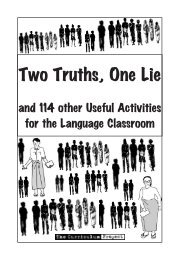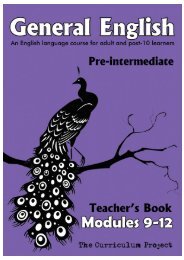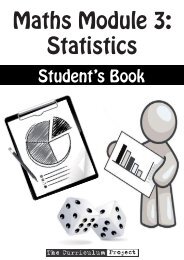Teacher's Guide - The Curriculum Project
Teacher's Guide - The Curriculum Project
Teacher's Guide - The Curriculum Project
- No tags were found...
You also want an ePaper? Increase the reach of your titles
YUMPU automatically turns print PDFs into web optimized ePapers that Google loves.
Production (cont’d)2. LABOURBrainstormOn Your Own1. Brainstorm jobs in the school. Make two columns on the board, Paid andUnpaid, and put each job into the appropriate column. Ask students whythey think that some jobs are paid, but others unpaid. (You could also getthe students to walk around their community in pairs, spot different kinds oflabour, and write a list).2. <strong>The</strong> pictures show the following kinds of labour:a. women making cheroots in a factoryb. a man harvesting ricec. a woman looking after her childd. men tending machines in a modern factoryKo Shwe & Naw Berry. Ask one of the students to read the text aloud to therest of the class. <strong>The</strong>n ask student to read it on their own.Discussion3. Put the students into groups of 3-5. Have them discuss the questions aboutKo Shwe and Naw Berry among themselves and write down their ideas. <strong>The</strong>nlead a discussion by eliciting opinions from different students.Ko Shwe’s labour is paid, but Naw Berry’s labour is unpaid. Why? Is Ko Shwe’s labour morevaluable then Naw Berry’s? Does Ko Shwe work harder than Naw Berry?GroupworkIn most societies, parents who raise their children and manage a household are not paid for thiswork. <strong>The</strong> home is the private family space and family members are expected to manage it withoutexpecting any payment because this work is purely for their own benefit. However, in many societies,it is women who are are seen as the ‘natural’ and ‘traditional’ homemakers and childcarers, andtherefore do most of the work that occurs in the home. In some cases, they do not have any opportunityto work outside the home and earn money for themselves. In other cases they do paid work outsidethe home, but are expected to do the major share of the work in the home too (this is called the‘double burden’). In these cases, the paid work that men do outside the home is usually consideredto be the most important, while the paid work that women do is seen as ‘secondary’. <strong>The</strong>refore,women are mainly defined by the work that they do within the home, for which they are not paid.This raises important questions about equal opportunities between men and women, the control ofwomen’s access to the economic arena, and the control that women have over their own lives.Labour SegregationPre-teach: to segregate (noun): to divide, to separate; to specialise: to focus on a smallnumber of tasks.Ask students to read the text about ‘Labour Segregation’.4. Put students into groups of 3-5. Ask them to identify three types of labourin their community. Is it paid or unpaid? Do both men and women do thiskind of labour? If so, who does more, men or women? Is it segregated inother ways (ethnicity, wealth, age, social status, etc.)? Give them 10 mins todiscuss and write ideas. <strong>The</strong>n ask each group to present ideas to the class.<strong>The</strong> <strong>Curriculum</strong> <strong>Project</strong> ECONOMICS: an introduction - Teacher’s <strong>Guide</strong>33













![[Eng] Nov 2012 DRAFT - The Curriculum Project](https://img.yumpu.com/45590859/1/184x260/eng-nov-2012-draft-the-curriculum-project.jpg?quality=85)


